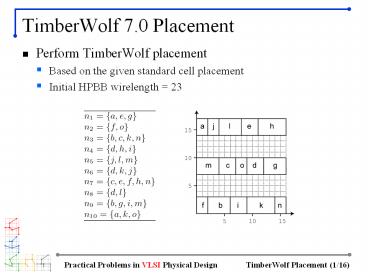TimberWolf%207.0%20Placement - PowerPoint PPT Presentation
Title:
TimberWolf%207.0%20Placement
Description:
Practical Problems in VLSI Physical Design. TimberWolf Placement (1 /16) ... Practical Problems in VLSI Physical Design. TimberWolf Placement (5 /16) ... – PowerPoint PPT presentation
Number of Views:90
Avg rating:3.0/5.0
Title: TimberWolf%207.0%20Placement
1
TimberWolf 7.0 Placement
- Perform TimberWolf placement
- Based on the given standard cell placement
- Initial HPBB wirelength 23
2
First Swap
- Swap node b and e
- We shift node h on the shorter side of the
receiving row - Node b included in nets n3, n9, and e in n1,
n7
3
Computing ?W
- ?W wirelength change from swap
4
Estimating ?Ws
- ?Ws wirelength change from shifting
- h is shifted and included in n4 d,h,i and n7
c,e,f,h,n - h is on the right boundary of n4 gradient(h)
- h is not on any boundary of n7 no further change
on gradient(h)
5
Estimating ?Ws (cont)
6
Accuracy of ?Ws Estimation
- How accurate is ?Ws estimation?
- Node h is included in n4 d,h,i and n7
c,e,f,h,n - Real change is also 1 accurate estimation
7
Estimation Model B
- Based on piecewise linear graph
- Shifting h causes the wirelength of n4 to
increase by 1 (19 to 20) and no change on n7
(stay at 28)
8
Second Swap
- Swap node m and o
- We shift node d and g on the shorter side of the
receiving row - Node m included in nets n5, n9, and o in n2,
n10
9
Computing ?W
- ?W wirelength change from swap
10
Estimating ?Ws
- Cell d and g are shifted
- d is included in n4 d,h,i, n6 d,k,j, and
n8 d,l - d is on the right boundary of n6 and n8
- So, gradient(d) 2
11
Estimating ?Ws (cont)
- Cell d and g are shifted
- g is included in n1 a,e,g, and n9 b,g,i,m
- g is on the right boundary of n1 and n9
- So, gradient(g) 2
12
Estimating ?Ws (cont)
13
Third Swap
- Swap node k and m
- We shift node c on the shorter side of the
receiving row - Node k included in nets n3, n6 , n10, and m in
n5, n9
14
Computing ?W
- ?W wirelength change from swap
15
Estimating ?Ws
- Cell c is shifted
- c is included in n3 b,c,k,n and n7
c,e,f,h,n - c is on the left boundary of n3
- So, gradient(c) -1
16
Estimating ?Ws (cont)































